

Compact Muon Solenoid
LHC, CERN
| CMS-B2G-21-004 ; CERN-EP-2022-153 | ||
| Search for pair-produced vector-like leptons in final states with third-generation leptons and at least three b quark jets in proton-proton collisions at $ \sqrt{s}= $ 13 TeV | ||
| CMS Collaboration | ||
| 20 August 2022 | ||
| Phys. Lett. B 846 (2023) 137713 | ||
| Abstract: The first search is presented for vector-like leptons (VLLs) in the context of the ``4321 model'', an ultraviolet-complete model with the potential to explain existing $ {\mathrm{B}} $ physics measurements that are in tension with standard model predictions. The analyzed data, corresponding to an integrated luminosity of 96.5 fb$ ^{-1} $, were recorded in 2017 and 2018 with the CMS detector at the LHC in proton-proton collisions at $ \sqrt{s}= $ 13 TeV. Final states with $ {\geq} $3 b-tagged jets and two third-generation leptons ($ \tau\tau $, $ \tau\nu_{\!\tau} $, or $ \nu_{\!\tau}\nu_{\!\tau} $) are considered. Upper limits are derived on the VLL production cross section in the VLL mass range 500--1050 GeV. The maximum likelihood fit prefers the presence of signal at the level of 2.8 standard deviations, for a representative VLL mass point of 600 GeV. As a consequence, the observed upper limits are approximately double the expected limits. | ||
| Links: e-print arXiv:2208.09700 [hep-ex] (PDF) ; CDS record ; inSPIRE record ; HepData record ; CADI line (restricted) ; | ||
| Figures | |

png pdf |
Figure 1:
Left side: example Feynman diagrams showing electroweak production of VLL pairs through $s$-channel bosons, as expected at the LHC. In these diagrams, L represents either the neutral VLL, N, or the charged VLL, E. Right side: vector-like lepton decays are mediated by a vector leptoquark, U. These decays are primarily to third-generation leptons and quarks. |

png pdf |
Figure 1-a:
Example Feynman diagram showing electroweak production of VLL pairs through $s$-channel bosons, as expected at the LHC. |

png pdf |
Figure 1-b:
Example Feynman diagram showing electroweak production of VLL pairs through $s$-channel bosons, as expected at the LHC. |
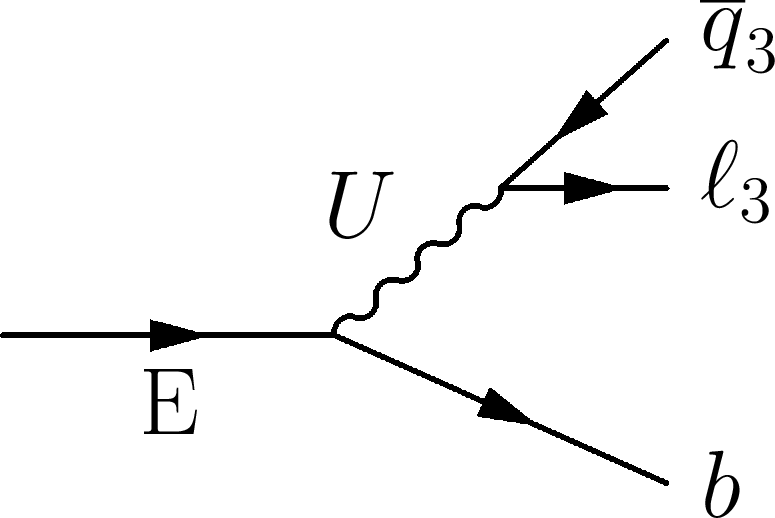
png pdf |
Figure 1-c:
Vector-like lepton decays are mediated by a vector leptoquark, U. These decays are primarily to third-generation leptons and quarks. |
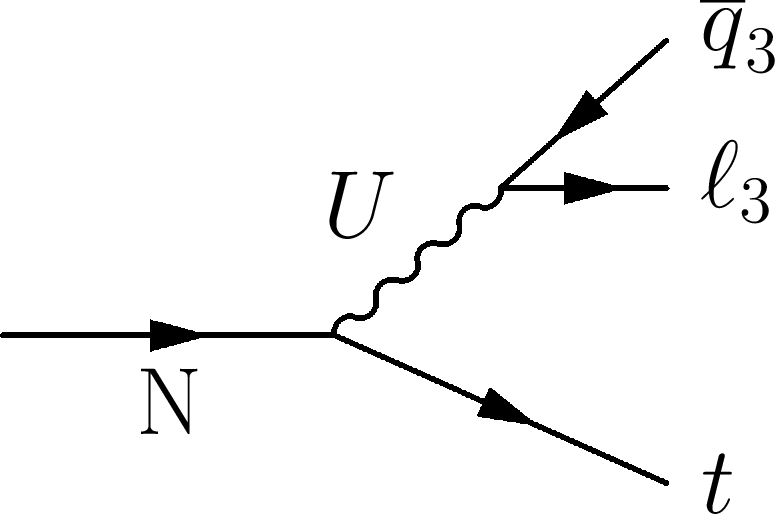
png pdf |
Figure 1-d:
Vector-like lepton decays are mediated by a vector leptoquark, U. These decays are primarily to third-generation leptons and quarks. |

png pdf |
Figure 2:
Diagram of the event categorization and the various signal and control regions used in the analysis. The regions within the solid box are all used in the signal extraction fit. The regions in the dashed box are used to determine transfer factors from the control regions to the signal region for events with jets misidentified as ${\tau _\mathrm {h}}$'s. The selections are mutually exclusive between all regions, so that each event only enters a single region. For brevity, not all selection criteria are shown; the detailed selection criteria are described in the text. |
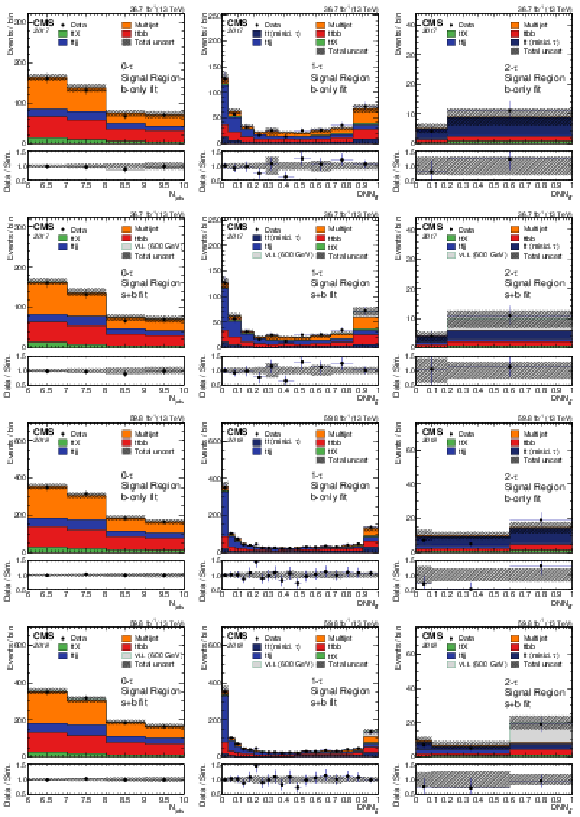
png pdf |
Figure 3:
Postfit plots for 2017 (top two rows) and 2018 (bottom two rows) showing the fitted distributions in the signal region for the different ${\tau _\mathrm {h}}$ multiplicity channels (from left to right: 0-${\tau _\mathrm {h}}$, 1-${\tau _\mathrm {h}}$, 2-${\tau _\mathrm {h}}$). The jet multiplicity is fit for the 0-${\tau _\mathrm {h}}$ region, whereas the ${\mathrm {DNN}_{{\mathrm{t} \mathrm{\bar{t}}}}}$ score is fit for the 1-${\tau _\mathrm {h}}$ and 2-${\tau _\mathrm {h}}$ regions. The first and third row show the background-only fits and the second and fourth rows show the fit including the signal. |

png pdf |
Figure 3-a:
Postfit plots for 2017 showing the fitted distribution in the signal region for the 0-${\tau _\mathrm {h}}$ multiplicity channel, for which the jet multiplicity is fit. Shown is the background-only fit. |

png pdf |
Figure 3-b:
Postfit plots for 2017 showing the fitted distribution in the signal region for the 1-${\tau _\mathrm {h}}$ multiplicity channel, for which the ${\mathrm {DNN}_{{\mathrm{t} \mathrm{\bar{t}}}}}$ score is fit. Shown is the background-only fit. |
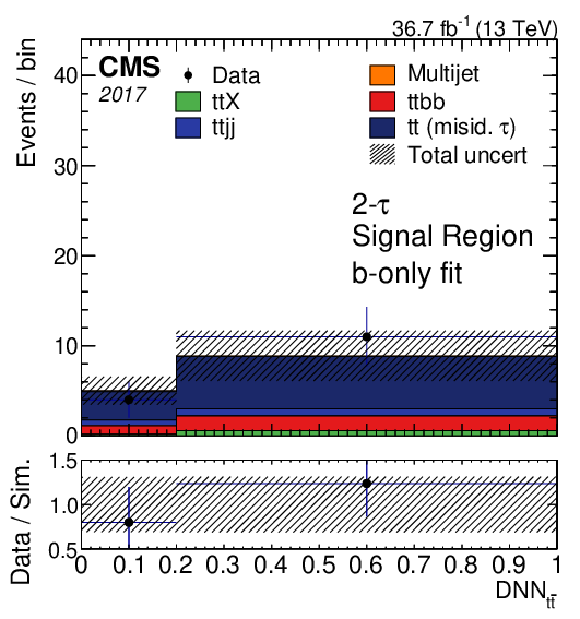
png pdf |
Figure 3-c:
Postfit plots for 2017 showing the fitted distribution in the signal region for the 2-${\tau _\mathrm {h}}$ multiplicity channel, for which ${\mathrm {DNN}_{{\mathrm{t} \mathrm{\bar{t}}}}}$ score is fit. Shown is the background-only fit. |

png pdf |
Figure 3-d:
Postfit plots for 2017 showing the fitted distribution in the signal region for the 0-${\tau _\mathrm {h}}$ multiplicity channel, for which the jet multiplicity is fit. Shown is the fit including the signal. |
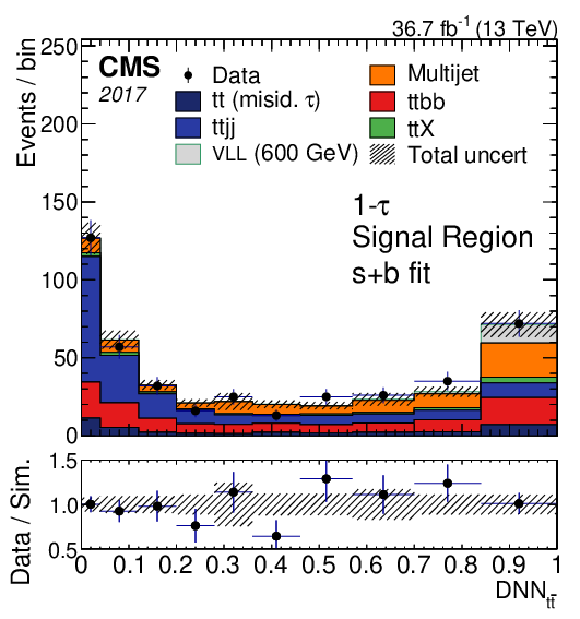
png pdf |
Figure 3-e:
Postfit plots for 2017 showing the fitted distribution in the signal region for the 1-${\tau _\mathrm {h}}$ multiplicity channel, for which the ${\mathrm {DNN}_{{\mathrm{t} \mathrm{\bar{t}}}}}$ score is fit. Shown is the fit including the signal. |

png pdf |
Figure 3-f:
Postfit plots for 2017 showing the fitted distribution in the signal region for the 2-${\tau _\mathrm {h}}$ multiplicity channel, for which the ${\mathrm {DNN}_{{\mathrm{t} \mathrm{\bar{t}}}}}$ score is fit. Shown is the fit including the signal. |

png pdf |
Figure 3-g:
Postfit plots for 2018 showing the fitted distribution in the signal region for the 1-${\tau _\mathrm {h}}$ multiplicity channel, for which the ${\mathrm {DNN}_{{\mathrm{t} \mathrm{\bar{t}}}}}$ score is fit. Shown is the background-only fit. |
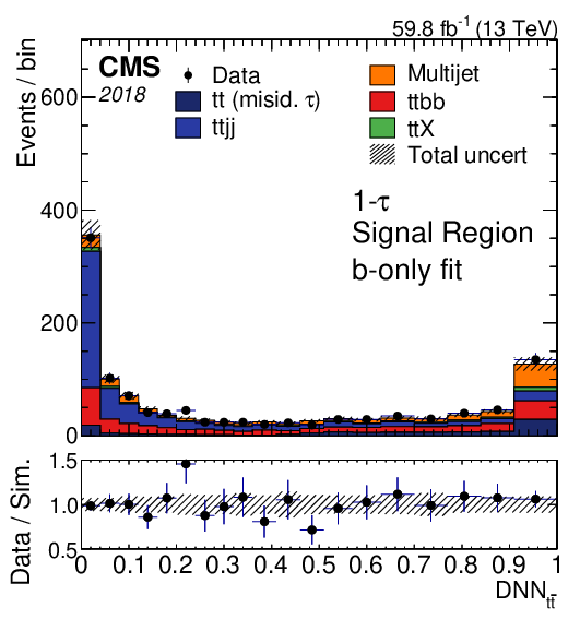
png pdf |
Figure 3-h:
Postfit plots for 2018 showing the fitted distribution in the signal region for the 2-${\tau _\mathrm {h}}$ multiplicity channel, for which ${\mathrm {DNN}_{{\mathrm{t} \mathrm{\bar{t}}}}}$ score is fit. Shown is the background-only fit. |
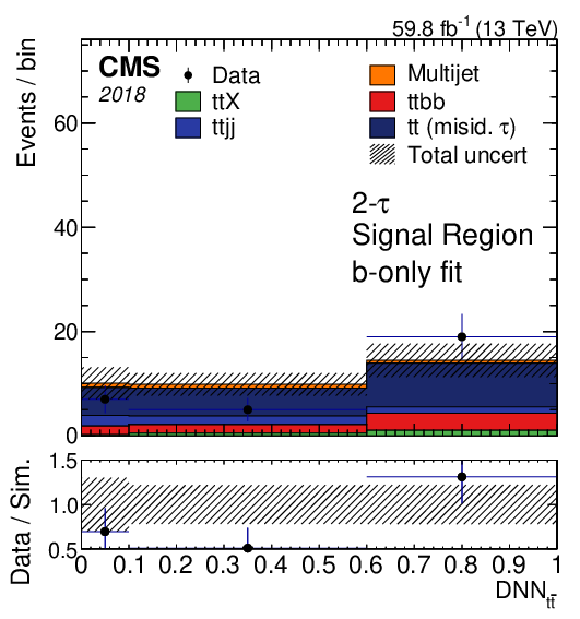
png pdf |
Figure 3-i:
Postfit plots for 2018 showing the fitted distribution in the signal region for the 0-${\tau _\mathrm {h}}$ multiplicity channel, for which the jet multiplicity is fit. Shown is the fit including the signal. |

png pdf |
Figure 3-j:
Postfit plots for 2018 showing the fitted distribution in the signal region for the 1-${\tau _\mathrm {h}}$ multiplicity channel, for which the ${\mathrm {DNN}_{{\mathrm{t} \mathrm{\bar{t}}}}}$ score is fit. Shown is the fit including the signal. |
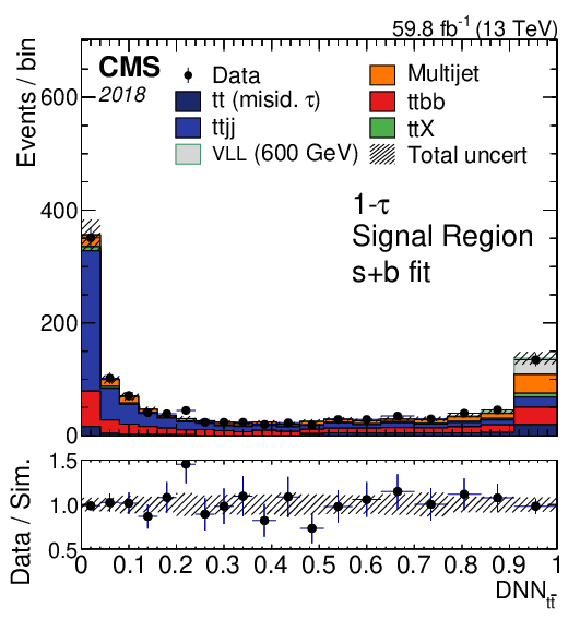
png pdf |
Figure 3-k:
Postfit plots for 2018 showing the fitted distribution in the signal region for the 2-${\tau _\mathrm {h}}$ multiplicity channel, for which the ${\mathrm {DNN}_{{\mathrm{t} \mathrm{\bar{t}}}}}$ score is fit. Shown is the fit including the signal. |
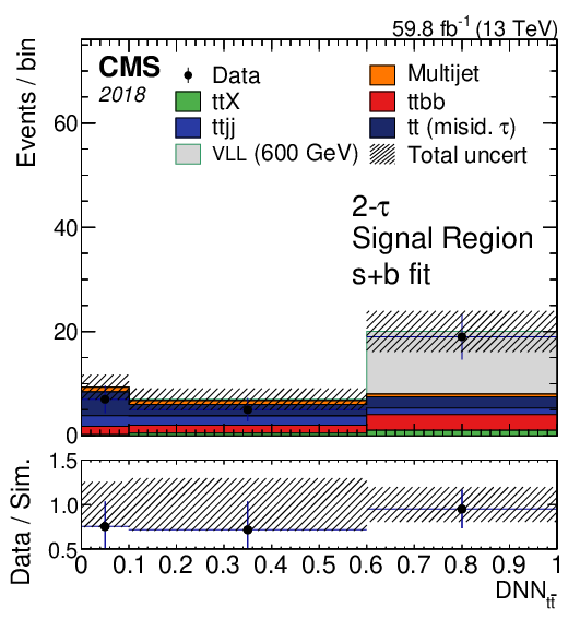
png pdf |
Figure 3-l:
Postfit plots for 2017 (top two rows) and 2018 (bottom two rows) showing the fitted distributions in the signal region for the different ${\tau _\mathrm {h}}$ multiplicity channels (from left to right: 0-${\tau _\mathrm {h}}$, 1-${\tau _\mathrm {h}}$, 2-${\tau _\mathrm {h}}$). The jet multiplicity is fit for the 0-${\tau _\mathrm {h}}$ region, whereas the ${\mathrm {DNN}_{{\mathrm{t} \mathrm{\bar{t}}}}}$ score is fit for the 1-${\tau _\mathrm {h}}$ and 2-${\tau _\mathrm {h}}$ regions. The first and third row show the background-only fits and the second and fourth rows show the fit including the signal. |
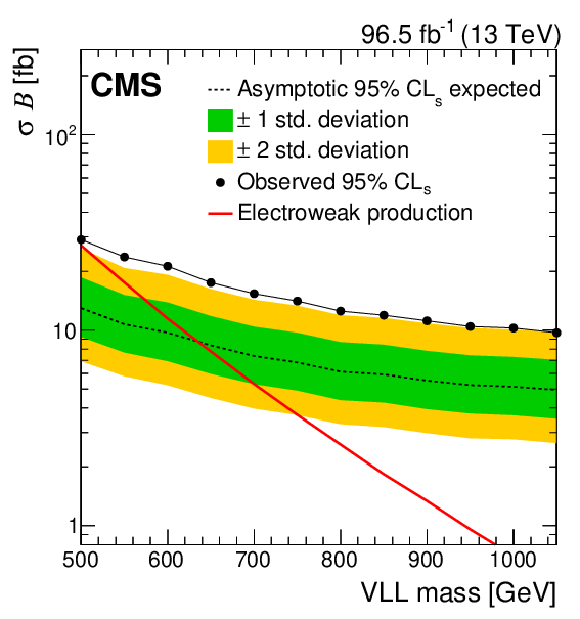
png pdf |
Figure 4:
Expected and observed 95% CL upper limits on the product of the VLL pair production cross section and the branching fraction to third generation quarks and leptons, combining the 2017 and 2018 data and all ${\tau _\mathrm {h}}$ multiplicity channels. The theoretical prediction in the 4321 model for electroweak production of {VLL}s is also shown. |
| Tables | |

png pdf |
Table 1:
Illustrative contributions from different VLL production and decay modes to the 0-$\tau$, 1-$\tau$, and 2-$\tau$ signal regions. The decay products in parentheses represent the objects coming from the intermediate vector leptoquark, U, in the decay. In the table, no distinction is made between particles and antiparticles, the multiplicities of each decay mode are not shown, and the impacts of object misidentification are not considered. The charged and neutral {VLL}s are represented by E and N; j represents any quark other than t or b. |

png pdf |
Table 2:
Estimated ${\tau _\mathrm {h}}$ identification efficiencies and jet misidentification rates for the DeepTau algorithm used in the analysis. |

png pdf |
Table 3:
List of input features used during training of the ABCNet model for VLL classification. |
| Summary |
| The first search for vector-like leptons (VLLs) in the context of the 4321 model has been presented, using proton-proton collision data collected with the CMS detector at $ \sqrt{s}= $ 13 TeV, corresponding to an integrated luminosity of 96.5 fb$ ^{-1} $. The probed model consists of an extension of the standard model with an SU(4) $\times$ SU(3)' $ \times$ SU(2)$_{\text{L}}$ $\times$ U(1)' gauge sector that can provide a combined explanation for multiple anomalies observed in b hadron decays, which point to lepton flavour nonuniversality. In the model, a leptoquark is predicted as the primary source of lepton flavour nonuniversality, while the ultraviolet-completion predicts additional vector-like fermion families. In particular, VLLs are investigated via their couplings to standard model fermions through leptoquark interactions, resulting in third-generation fermion signatures. Final states containing at least three b-tagged jets and varying $ \tau $ lepton multiplicities are considered. To improve the search sensitivity, graph neural networks are trained to discriminate between classes of events using the kinematic relationships between particles in an environment with high jet multiplicity. An excess of 2.8 standard deviations over the standard model background-only hypothesis was observed in the data at the representative VLL mass point of 600 GeV. As a result, no VLL masses are excluded at the 95% confidence level and limits on the product of the VLL pair production cross section and their branching ratio to third generation fermions are set between 10 and 30 fb, depending on the VLL mass hypothesis. |
| References | ||||
| 1 | L. Di Luzio, A. Greljo, and M. Nardecchia | Gauge leptoquark as the origin of B-physics anomalies | PRD 96 (2017) 115011 | 1708.08450 |
| 2 | L. Di Luzio et al. | Maximal flavour violation: a Cabibbo mechanism for leptoquarks | JHEP 11 (2018) 081 | 1808.00942 |
| 3 | M. Bordone, C. Cornella, J. Fuentes-Martin, and G. Isidori | A three-site gauge model for flavor hierarchies and flavor anomalies | PLB 779 (2018) 317 | 1712.01368 |
| 4 | A. Greljo and B. A. Stefanek | Third family quark-lepton unification at the TeV scale | PLB 782 (2018) 131 | 1802.04274 |
| 5 | CMS Collaboration | Precision luminosity measurement in proton-proton collisions at $ \sqrt{s} = $ 13 TeV in 2015 and 2016 at CMS | EPJC 81 (2021) 800 | CMS-LUM-17-003 2104.01927 |
| 6 | CMS Collaboration | CMS luminosity measurement for the 2017 data-taking period at $ \sqrt{s} = $ 13 TeV | CMS-PAS-LUM-17-004 | CMS-PAS-LUM-17-004 |
| 7 | CMS Collaboration | CMS luminosity measurement for the 2018 data-taking period at $ \sqrt{s} = $ 13 TeV | CMS-PAS-LUM-18-002 | CMS-PAS-LUM-18-002 |
| 8 | BaBar Collaboration | Evidence for an excess of $ \bar{B} \to D^{(*)} \tau^-\bar{\nu}_\tau $ decays | PRL 109 (2012) 101802 | 1205.5442 |
| 9 | BaBar Collaboration | Measurement of an excess of $ \bar{B} \to D^{(*)}\tau^- \bar{\nu}_\tau $ decays and implications for charged Higgs bosons | PRD 88 (2013) 072012 | 1303.0571 |
| 10 | LHCb Collaboration | Measurement of the ratio of branching fractions $ \mathcal{B}(\bar{B}^0 \to D^{*+}\tau^{-}\bar{\nu}_{\tau})/\mathcal{B}(\bar{B}^0 \to D^{*+}\mu^{-}\bar{\nu}_{\mu}) $ | PRL 115 (2015) 111803 | 1506.08614 |
| 11 | Belle Collaboration | Measurement of the branching ratio of $ \bar{B} \to D^{(\ast)} \tau^- \bar{\nu}_\tau $ relative to $ \bar{B} \to D^{(\ast)} \ell^- \bar{\nu}_\ell $ decays with hadronic tagging at Belle | PRD 92 (2015) 072014 | 1507.03233 |
| 12 | Belle Collaboration | Measurement of the $ \tau $ lepton polarization and $ \mathrm{R}(D^*) $ in the decay $ \bar{B} \to D^* \tau^- \bar{\nu}_\tau $ | PRL 118 (2017) 211801 | 1612.00529 |
| 13 | LHCb Collaboration | Test of lepton flavor universality by the measurement of the $ B^0 \to D^{*-} \tau^+ \nu_{\tau} $ branching fraction using three-prong $ \tau $ decays | PRD 97 (2018) 072013 | 1711.02505 |
| 14 | Belle Collaboration | Measurement of the $ \tau $ lepton polarization and $ R(D^*) $ in the decay $ \bar{B} \rightarrow D^* \tau^- \bar{\nu}_\tau $ with one-prong hadronic $ \tau $ decays at Belle | PRD 97 (2018) 012004 | 1709.00129 |
| 15 | LHCb Collaboration | Measurement of the ratio of the $ B^0 \to D^{*-} \tau^+ \nu_{\tau} $ and $ B^0 \to D^{*-} \mu^+ \nu_{\mu} $ branching fractions using three-prong $ \tau $-lepton decays | PRL 120 (2018) 171802 | 1708.08856 |
| 16 | Belle Collaboration | Measurement of $ \mathcal{R}(D) $ and $ \mathcal{R}(D^*) $ with a semileptonic tagging method | PRL 124 (2020) 161803 | 1910.05864 |
| 17 | M. Blanke and A. Crivellin | $ B $ meson anomalies in a Pati-Salam model within the Randall-Sundrum background | PRL 121 (2018) 011801 | 1801.07256 |
| 18 | L. Calibbi, A. Crivellin, and T. Li | Model of vector leptoquarks in view of the $ B $-physics anomalies | PRD 98 (2018) 115002 | 1709.00692 |
| 19 | CMS Collaboration | Search for vector-like leptons in multilepton final states in proton-proton collisions at $ \sqrt{s} = $ 13 TeV | PRD 100 (2019) 052003 | CMS-EXO-18-005 1905.10853 |
| 20 | F. Abe, D. Amidei, G. Apollinari, and M. Atac | Measurement of the ratio B(W$ \rightarrow \tau \nu$)/B(W$\rightarrow e \nu$) in $ p\bar{p} $ collisions at $ \sqrt{s} = $ 1.8 TeV | PRL 68 (1992) 3398 | |
| 21 | D0 Collaboration | A measurement of the $ W \to \tau \nu $ production cross section in $ p\bar{p} $ collisions at $ \sqrt{s} = $ 1.8 TeV | PRL 84 (2000) 5710 | hep-ex/9912065 |
| 22 | LHCb Collaboration | Measurement of forward $ W\to e\nu $ production in $ pp $ collisions at $ \sqrt{s}= $ 8 TeV | JHEP 10 (2016) 030 | 1608.01484 |
| 23 | ATLAS Collaboration | Test of the universality of $ \tau $ and $ \mu $ lepton couplings in $ W $-boson decays with the ATLAS detector | NP 17 (2021) 813 | 2007.14040 |
| 24 | C. Cornella et al. | Reading the footprints of the B-meson flavor anomalies | JHEP 08 (2021) 050 | 2103.16558 |
| 25 | T. Hastie, R. Tibshirani, and J. Friedman | The elements of statistical learning | Springer-Verlag, second edition, 2013 , ISBN 978-0-387-84858-7 | |
| 26 | V. Mikuni and F. Canelli | ABCNet: An attention-based method for particle tagging | EPJPlus 135 (2020) 463 | 2001.05311 |
| 27 | G. Kasieczka, B. Nachman, M. D. Schwartz, and D. Shih | Automating the ABCD method with machine learning | PRD 103 (2021) 035021 | 2007.14400 |
| 28 | CMS Collaboration | HEPData record for this analysis | link | |
| 29 | CMS Collaboration | The CMS experiment at the CERN LHC | JINST 3 (2008) S08004 | CMS-00-001 |
| 30 | CMS Collaboration | Performance of the CMS Level-1 trigger in proton-proton collisions at $ \sqrt{s} = $ 13 TeV | JINST 15 (2020) P10017 | CMS-TRG-17-001 2006.10165 |
| 31 | CMS Collaboration | The CMS trigger system | JINST 12 (2017) P01020 | CMS-TRG-12-001 1609.02366 |
| 32 | CMS Collaboration | Technical proposal for the Phase-II upgrade of the Compact Muon Solenoid | CMS-PAS-TDR-15-002 | CMS-PAS-TDR-15-002 |
| 33 | CMS Collaboration | Particle-flow reconstruction and global event description with the CMS detector | JINST 12 (2017) P10003 | CMS-PRF-14-001 1706.04965 |
| 34 | M. Cacciari, G. P. Salam, and G. Soyez | The anti-$ {k_{\mathrm{T}}} $ jet clustering algorithm | JHEP 04 (2008) 063 | 0802.1189 |
| 35 | M. Cacciari, G. P. Salam, and G. Soyez | FastJet user manual | EPJC 72 (2012) 1896 | 1111.6097 |
| 36 | CMS Collaboration | Pileup mitigation at CMS in 13 TeV data | JINST 15 (2020) P09018 | CMS-JME-18-001 2003.00503 |
| 37 | CMS Collaboration | Jet energy scale and resolution in the CMS experiment in pp collisions at 8 TeV | JINST 12 (2017) P02014 | CMS-JME-13-004 1607.03663 |
| 38 | CMS Collaboration | Identification of heavy-flavour jets with the CMS detector in pp collisions at 13 TeV | JINST 13 (2018) P05011 | CMS-BTV-16-002 1712.07158 |
| 39 | E. Bols et al. | Jet flavour classification using DeepJet | JINST 15 (2020) P12012 | 2008.10519 |
| 40 | CMS Collaboration | Performance of the DeepJet b tagging algorithm using 41.9 fb$^{-1}$ of data from proton-proton collisions at 13 TeV with Phase 1 CMS detector | CDS | |
| 41 | CMS Collaboration | Performance of reconstruction and identification of $ \tau $ leptons decaying to hadrons and $ \nu_\tau $ in pp collisions at $ \sqrt{s}= $ 13 TeV | JINST 13 (2018) P10005 | CMS-TAU-16-003 1809.02816 |
| 42 | CMS Collaboration | Identification of hadronic tau lepton decays using a deep neural network | JINST 17 (2022) P07023 | CMS-TAU-20-001 2201.08458 |
| 43 | CMS Collaboration | Performance of missing transverse momentum reconstruction in proton-proton collisions at $ \sqrt{s} = $ 13 TeV using the CMS detector | JINST 14 (2019) P07004 | CMS-JME-17-001 1903.06078 |
| 44 | CMS Collaboration | CMS technical design report for the pixel detector upgrade | CDS | |
| 45 | CMS Collaboration | Performance of b tagging algorithms in proton-proton collisions at 13 TeV with Phase 1 CMS detector | CDS | |
| 46 | J. Alwall et al. | The automated computation of tree-level and next-to-leading order differential cross sections, and their matching to parton shower simulations | JHEP 07 (2014) 079 | 1405.0301 |
| 47 | A. Alloul et al. | FeynRules 2.0 -- a complete toolbox for tree-level phenomenology | CPC 185 (2014) 2250 | 1310.1921 |
| 48 | T. Sjostrand et al. | An introduction to PYTHIA 8.2 | CPC 191 (2015) 159 | 1410.3012 |
| 49 | CMS Collaboration | Extraction and validation of a new set of CMS PYTHIA8 tunes from underlying-event measurements | EPJC 80 (2020) 4 | CMS-GEN-17-001 1903.12179 |
| 50 | R. D. Ball et al. | Parton distributions from high-precision collider data | EPJC 77 (2017) 663 | 1706.00428 |
| 51 | P. Nason | A new method for combining NLO QCD with shower Monte Carlo algorithms | JHEP 11 (2004) 040 | hep-ph/0409146 |
| 52 | S. Frixione, P. Nason, and C. Oleari | Matching NLO QCD computations with parton shower simulations: the POWHEG method | JHEP 11 (2007) 070 | 0709.2092 |
| 53 | S. Alioli, P. Nason, C. Oleari, and E. Re | A general framework for implementing NLO calculations in shower Monte Carlo programs: the POWHEG BOX | JHEP 06 (2010) 043 | 1002.2581 |
| 54 | M. Beneke, P. Falgari, S. Klein, and C. Schwinn | Hadronic top-quark pair production with NNLL threshold resummation | NPB 855 (2012) 695 | 1109.1536v1 |
| 55 | M. Cacciari et al. | Top-pair production at hadron colliders with next-to-next-to-leading logarithmic soft-gluon resummation | PLB 710 (2012) 612 | 1111.5869 |
| 56 | P. Barnreuther, M. Czakon, and A. Mitov | Percent-level-precision physics at the Tevatron: Next-to-next-to-leading order QCD corrections to $ q\bar{q} \to t\bar{t}+X $ | PRL 109 (2012) 132001 | 1204.5201 |
| 57 | M. Czakon and A. Mitov | NNLO corrections to top-pair production at hadron colliders: the all-fermionic scattering channels | JHEP 12 (2012) 054 | 1207.0236 |
| 58 | M. Czakon and A. Mitov | NNLO corrections to top pair production at hadron colliders: the quark-gluon reaction | JHEP 01 (2013) 080 | 1210.6832 |
| 59 | M. Czakon, P. Fiedler, and A. Mitov | Total top-quark pair-production cross section at hadron colliders through O($ \alpha_S^4 $) | PRL 110 (2013) 252004 | 1303.6254 |
| 60 | M. Czakon and A. Mitov | Top++: a program for the calculation of the top-pair cross-section at hadron colliders | CPC 185 (2014) 2930 | 1112.5675 |
| 61 | CMS Collaboration | Measurements of $ \mathrm{t \bar{t}} $ cross sections in association with b jets and inclusive jets and their ratio using dilepton final states in pp collisions at $ \sqrt{s} = $ 13 TeV | PLB 776 (2018) 355 | CMS-TOP-16-010 1705.10141 |
| 62 | ATLAS Collaboration | Measurements of inclusive and differential fiducial cross-sections of $ \mathrm{t\bar{t}} $ production with additional heavy-flavour jets in proton-proton collisions at $ \sqrt{s} = $ 13 TeV with the ATLAS detector | JHEP 04 (2019) 046 | 1811.12113 |
| 63 | CMS Collaboration | Measurement of the $ \mathrm{t\bar{t}}\mathrm{b\bar{b}} $ production cross section in the all-jet final state in pp collisions at $ \sqrt{s} = $ 13 TeV | PLB 803 (2020) 135285 | CMS-TOP-18-011 1909.05306 |
| 64 | CMS Collaboration | Measurement of the cross section for $ \mathrm{t\bar{t}} $ production with additional jets and b jets in pp collisions at $ \sqrt{s} = $ 13 TeV | JHEP 07 (2020) 125 | CMS-TOP-18-002 2003.06467 |
| 65 | GEANT4 Collaboration | GEANT4--a simulation toolkit | NIMA 506 (2003) 250 | |
| 66 | R. J. Barlow and C. Beeston | Fitting using finite Monte Carlo samples | CPC 77 (1993) 219 | |
| 67 | J. Butterworth et al. | PDF4LHC recommendations for LHC Run II | JPG 43 (2016) 023001 | 1510.03865 |
| 68 | T. Junk | Confidence level computation for combining searches with small statistics | NIMA 434 (1999) 435 | hep-ex/9902006 |
| 69 | A. L. Read | Presentation of search results: The CL$ _{\text{s}} $ technique | JPG 28 (2002) 2693 | |
| 70 | G. Cowan, K. Cranmer, E. Gross, and O. Vitells | Asymptotic formulae for likelihood-based tests of new physics | EPJC 71 (2011) 1554 | 1007.1727 |
| 71 | S. S. Wilks | The large-sample distribution of the likelihood ratio for testing composite hypotheses | Ann. Math. Statist. 9 (1938) 60 | |

|
Compact Muon Solenoid LHC, CERN |

|

|

|

|

|

|